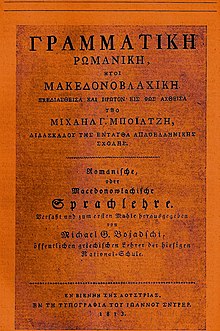അറൊമാനിയൻ ഭാഷ
ദൃശ്യരൂപം
| Aromanian | |
|---|---|
| armãneashce, armãneashti, rrãmãneshti. | |
| ഉത്ഭവിച്ച ദേശം | Greece, Albania, Romania, Republic of Macedonia, Serbia, Bulgaria, Turkey. |
മാതൃഭാഷയായി സംസാരിക്കുന്നവർ | (estimated 250,000 cited 1997)[1] |
പൂർവ്വികരൂപം | |
| Latin (Aromanian alphabet) | |
| ഔദ്യോഗിക സ്ഥിതി | |
Recognised minority language in | |
| ഭാഷാ കോഡുകൾ | |
| ISO 639-2 | rup |
| ISO 639-3 | rup |
| ഗ്ലോട്ടോലോഗ് | arom1237[2] |
| Linguasphere | 51-AAD-ba |
| Part of a series on |
| Aromanians |
|---|
| By region or country |
| Major settlements |
| Language |
| Religion |
| History |
| Related groups |
| Eastern Romance languages |
|---|
|
Vulgar Latin language Substratum Thraco-Roman culture |
| Romanian |
|
| Aromanian |
| Megleno-Romanian |
| Istro-Romanian |

അറൊമാനിയൻ ഭാഷ (limba armãneascã, armãneshce, armãneashti, rrãmãneshti)മാസിഡോ-റൊമാനിയൻ, വ്ലാഷ് എന്നുമറിയപ്പെടുന്നു. ഇത് തെക്കുകിഴക്കൻ യൂറോപ്പിൽ സംസാരിക്കുന്നു. ഇത് സംസാരിക്കുന്നത്, അറോമാനിയൻ അല്ലെങ്കിൽ വ്ലാഷുകൾ ആണ്.
ആധുനിക റൊമാനിയക്കാരുമായി ഇവർക്ക് വലിയ പരസ്പരബന്ധം നിലവിലുണ്ട്. ലാറ്റിൻ ഭാഷയിൽനിന്നും പാരമ്പര്യമായി ലഭിച്ച വലിയ പദസഞ്ചയവും ഒരേപോലുള്ള രൂപഘടനയും ഭാഷാപ്രത്യേകതകളും രണ്ടുപേർക്കും പൊതുവായുണ്ട്. ഇവതമ്മിൽ വലിയ വ്യത്യാസവുമുണ്ട്. റൊമാനിയൻ ഭാഷയ്ക്ക് സ്ലാവിക്ക് ഭാഷകളുമായാണ് കൂടുതൽ ബന്ധം. എന്നാൽ, അറൊമാനിയൻ ഭാഷകൾക്ക് ഗ്രീക്ക് ഭാഷയുമായാണ് കൂടുതൽ ബന്ധം.
ഭൂമിശാസ്ത്രപരമായ വിതരണം
[തിരുത്തുക]ഔദ്യോഗികപദവി
[തിരുത്തുക]ചരിത്രം
[തിരുത്തുക]ഭാഷാഭേതങ്ങൾ
[തിരുത്തുക]ശബ്ദശാസ്ത്രം
[തിരുത്തുക]വ്യാകരണം
[തിരുത്തുക]
ക്രിയകൾ
[തിരുത്തുക]ഗ്രീസിലെ അവസ്ഥ
[തിരുത്തുക]ഭാഷയുടെ ഉദാഹരണങ്ങൾ
[തിരുത്തുക]റൊമാനിയനുമായി താരതമ്യം
[തിരുത്തുക]പൊതുവായ വാക്കുകളും വാക്യഘടനയും
[തിരുത്തുക]ഇതും കാണൂ
[തിരുത്തുക]അവലംബം
[തിരുത്തുക]- Bara, Mariana. Le lexique latin hérité en aroumain dans une perspective romane, LincomEuropa Verlag, München, 2004, 231 p.; ISBN 3-89586-980-5.
- Bara, Mariana. Limba armănească. Vocabular şi stil. Bucharest: Editura Cartea Universitară. 2007, ISBN 978-973-731-551-9.
- Berciu-Drăghicescu, Adina; Petre, Maria. "Şcoli şi Biserici româneşti din Peninsula Balcanică. Documente (1864–1948)". Bucharest: Editura Universităţii. 2004.
- Capidan, Theodor. Aromânii, dialectul Aromân. Academia Română, Studii şi Cercetări, XX 1932.
- Friedman, Victor A. "The Vlah Minority in Macedonia: Language, Identity, Dialectology, and Standardization." In Selected Papers in Slavic, Balkan, and Balkan Studies, ed. Juhani Nuoluoto, Martti Leiwo, Jussi Halla-aho. Slavica Helsingiensa 21. University of Helsinki, 2001. online
- Kahl, Thede. "Aromanians in Greece: Minority or Vlach-speaking Greeks?". farsarotul.org.
- Kahl, Thede. Sprache und Intention der ersten aromunischen Textdokumente, 1731–1809. In: Symanzik, Bernhard (ed.): Festschrift für Gerhard Birkfellner zum 65. Geburtstag: Studia Philologica Slavica I/I, Münstersche Texte zur Slavistik, 2006, p. 245–266.
- Pascu, Giorge. Dictionnaire étymologique macédoroumain, 2 vols. Iaşi: Cultura Naţionalâ. 1918.
- Rosetti, Alexandru. Istoria limbii române, 2 vols., Bucharest. 1965–1969.
- "The Little Prince" by Antoine de Saint-Exupéry in Aromanian. Njiclu amirārush. Translated by Maria Bara and Thede Kahl, ISBN 978-3-937467-37-5.
- Weigand, Gustav. Die Sprache der Olympo-Wallachen, nebst einer Einleitung über Land und Leute. Leipzig: Johann Ambrosius Barth. 1888.
അടിക്കുറിപ്പുകൾ
[തിരുത്തുക]- ↑ Council of Europe Parliamentary Recommendation 1333 on the Aromanian culture and language (1997)
- ↑ Hammarström, Harald; Forkel, Robert; Haspelmath, Martin, eds. (2017). "Aromanian". Glottolog 3.0. Jena, Germany: Max Planck Institute for the Science of Human History.
{{cite book}}: External link in|chapterurl=|chapterurl=ignored (|chapter-url=suggested) (help)
